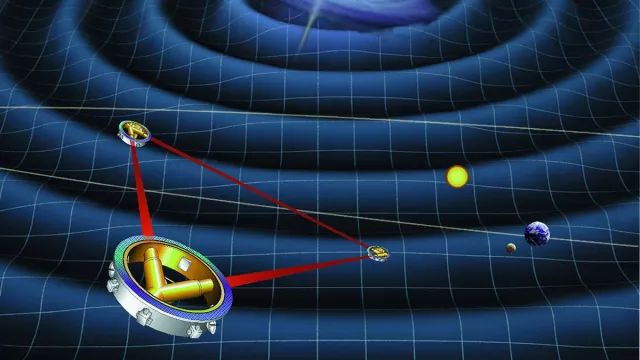LISA (Laser Interferometer Space Antenna) est une mission internationale de l'ESA qui a pour objectif la détection des ondes gravitationnelles émises par les évènements les plus violents de l'Univers.
Key information
| Mission | Detect gravitational waves in a new frequency range from space |
|---|---|
| Domain | Science |
| Launch date | Scheduled in 2035 |
| Partners | ESA and NASA |
| Where | Heliocentric orbit, trailing 50 million km behind Earth |
| Lifetime | At least 6½ years (2-year positioning and in-orbit commissioning phase, followed by 4½ years of science operations), with possible extension of 2½ years |
| Status | In development |
Key figures
- 2.5 million km: length of each interferometer arm
- 3 satellites making up the interferometer
- 10-11 m: precision with which the 2.5 million km separating each satellite will be measured
- 0.1 mHz-to-1 Hz frequency range
Key milestones
- 2037: Final positioning in space and start of science operations
- 2035: Launch of LISA
- 25 January 2024: ESA gives go-ahead to LISA mission
- 20 June 2017: LISA selected by ESA
- 3 December 2015: Launch of LISA Pathfinder
- 14 September 2015: Gravitational waves observed from Earth
- 1997: Project initiated by ESA and NASA
Project in brief
The LISA project is setting out to detect gravitational waves with three satellites trailing Earth in its orbit around the Sun. The satellites will form a giant laser interferometer in which each “arm” of the triangle will be 2.5 million kilometres long.
Predicted by Albert Einstein’s theory of general relativity in 1916, gravitational waves were observed for the first time from Earth in 2015. They are distant echoes of the most violent events in the cosmos. Travelling through space at the speed of light, gravitational waves are very hard to observe because the ripples they generate are infinitely small, and even the best Earth-bound instruments are limited by ambient noise in particular. In 2017, 20 years after the first concepts, ESA selected LISA as the third large-class mission (L3) of its Cosmic Vision programme, with launch scheduled for 2035.
LISA will consist of three satellites following the Earth around the Sun, trailing about 50 million kilometres behind the planet. Each satellite will be located at the point of an equilateral triangle 2.5 million kilometres on a side, forming a giant optical interferometer inclined at an angle of 60° to the plane of Earth’s orbit.
The satellites will be linked in pairs by identical synchronized laser beams to measure any relative movements between free-fall test masses inside each instrument. These test masses are isolated from external disturbances—solar wind, parasitic forces, etc.—and will reveal any infinitesimal distortions in space-time. The expected level of sensitivity is 10 picometres over a million kilometres, in a low-frequency range that the ground-based LIGO (Laser Interferometer Gravitational-wave Observatory) and Virgo facilities are unable to measure.
To accomplish this technological feat, CNES is working within the LISA consortium to federate a community of French research laboratories that will be making a major contribution to the mission. LISA-France—Institut Fresnel, APC, ARTEMIS/OCA, LAM, CPPM, LMA, Paris Observatory—is expected to be tasked with integrating and testing the instruments, and designing and developing the science ground segment. This work will entail a strong contribution to performance simulations and modelling, as well as preparing for scientific exploitation of mission data.
Between 2015 and 2017, ESA launched and operated a first technology demonstration mission called LISA Pathfinder. Its excellent results validated the key building blocks of the future LISA mission, notably the ability to maintain a test mass in purely gravitational free fall and obtain highly precise interferometric measurements inside the instrument.
CNES’s role
CNES is federating a community of French research laboratories with major responsibilities on the LISA mission.
The agency is leading two contributions on the spacecraft and a contribution on the ground:
Ground contribution: CNES is in charge of developing the Distributed Data Processing Centre (DDPC), where LISA data will be analysed daily during and after the mission.
The main processing centre will be in France, but each participating nation will have its own processing centre connected to the French centre.
Spacecraft contribution:
1) CNES is in charge of testing the instrument’s interferometric performance on two prototypes in Toulouse.
2) Optical Test System (OTS)
CNES is to supply test facilities to measure and verify the amount and effects of stray light along the instrument’s entire optical path. Stray light reflected and scattered inside the spacecraft’s optical instruments is a key concern and must be kept to a minimum.
Contacts
LISA Project Leader
Jean-Charles Damery
E-mail: jean-charles.damery at cnes.fr
Fundamental Physics subject matter expert
Martin Boutelier
E-mail: martin.boutelier at cnes.fr


